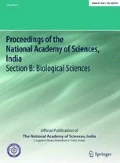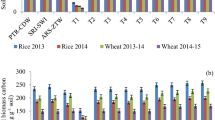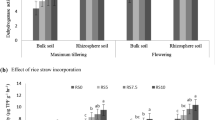Abstract
The present study shows the positive impact of application of tree leaves on soil microbial biomass and rice productivity. Chopped leaves of three nitrogen (N) rich tropical tree species, Dalbergia sissoo, Cassia fistula and Azadirachta indica alone and in combination with low quality wheat straw and chemical fertilizer alone were incorporated in soil to evaluate their effects on soil microbial biomass and biological productivity of rice crop under dryland conditions. D. sissoo, C. fistula and A. indica leaves had low lignin + polyphenol/N ratio (LIG + PPL/N, 4.5–12.4) as compared to combined treatments. Among tree leaf treatments, D. sissoo showed higher increase in mean microbial biomass C (195%) and N (242%) over control. In combination treatments, D. sissoo + wheat straw showed maximum microbial biomass C and N (242 and 25 μg g−1). The microbial biomass C and N remain low in fertilizer and wheat straw treatments. D. sissoo, C. fistula and A. indica leaf treatments showed about two times greater soil available-N as compared to control. In N rich species leaf treatments, total net productivity (TNP) was 68–161% greater than control whereas in combination and fertilizer treatments the increases were 23–48 and 14%, respectively. Among all treatments, application of D. sissoo, C. fistula and A. indica tree leaf alone showed substantially higher productivity than others. The addition of tree leaves caused comparable level of productivity, especially ANP, than in fertilizer alone treatment. Thus, direct application of N-rich tree species leaves that have low LIG + PPL/N ratio may serve as a short-term option for rapid enhancement of rice productivity and soil fertility.



Similar content being viewed by others
References
Kiers ET, Leakey RRB, Izac AJ, Heinemann A, Rosenthal E, Nathan D, Jiggins J (2008) Agriculture at a crossroads. Science 320:320–321
Abhilash PC, Dubey RK, Tripathi V, Srivastava P, Verma JP, Singh HB (2013) Remediation and management of POPs-contaminated soils in a warming climate: challenges and perspectives. Environ Sci Pollut Res 20:5879–5885
Singh P, Ghoshal N (2010) Variation in total biological productivity and soil microbial biomass in rainfed agroecosystems: impact of application of herbicide and soil amendments. Agric Ecosyst Environ 137:241–250
Srivastava R, Singh KP (2014) Variation in wheat yield, microbial biomass and N-availability in tropical dry land agroecosystem: impact of application of different tree leaves. Int J Curr Microbiol Appl Sci 3(4):830–842
Srivastava R, Singh KP (2012) Implications of multipurpose tree leaf application on wheat productivity in dry tropics. J Forest Res 24(4):777–782
Palm CA, Mayers RJK, Nandwa SM (1997) Combined use of organic and inorganic nutrient sources for soil fertility maintenance and replenishment. In: Buresh RJ, Sanchez PA, Cathoun F (eds) Replenishing soil fertility in Africa SSSA. Special publication no. 51. Soil Science Society of America, American Society of Agronomy, Madison, pp 193–217
Nyberg G, Ekblad A, Buresh R, Högberg P (2002) Short-term patterns of carbon and nitrogen mineralization in a fallow field amended with green manures from agroforestry trees. Biol Fertil Soils 36:18–25
Woomer PL, Martin A, Albrecht A, Resck DVS, Scharpenseel HW (1994) The importance and management of soil organic matter in the tropics. In: Woomer PL, Swift MJ (eds) The biological management of tropical soil fertility. Wiley-Spyce Publication, Chichester, pp 47–80
Piao HC, Wu YY, Hong YT, Yuan ZY (2000) Soil released carbon dioxide from microbial biomass carbon in the cultivated soils of karst areas of southwest China. Biol Fertil Soils 31:422–426
Srivastava R, Singh KP (2002) Variations in soil organic C and N storage due to cultivation practices in the Gangetic plain, India. Int J Ecol Environ Sci 28:193–199
JrJF McBrayer, Cromack K (1980) Effect of snow-pack on oak-litter breakdown and nutrient release in a Minnesota forest. Pedobiologia 20:47–54
Jackson ML (1973) Soil chemical analysis. Prentice-Hall, Inc., Englewood Cliffs
Effland MJ (1977) Modified procedure to determine acid insoluble lignin in wood and pulp. Tech Assoc Pulp Ind 60:143–144
Anderson JM, Ingram JSI (1993) Tropical soil biology and fertility: a handbook of methods. CAB International, Wallingford
Vance ED, Brookes PC, Jenkinson DS (1987) An extraction method for measuring soil microbial biomass C. Soil Biol Biochem 19:703–707
Brookes PC, Landman A, Pruden G, Jenkinson DS (1985) Chloroform fumigation and the release of soil nitrogen: a rapid direct extraction method to measure microbial biomass nitrogen in soil. Soil Biol Biochem 17:837–842
APHA, American Public Health Association (1995) Standard methods for examination of water and wastewater, 19th edn. American Public Health Association, Washington
Semwal RL, Maikhuri RK, Rao KS, Sen KK, Sexena KG (2003) Leaf litter decomposition and nutrient release patterns of six multipurpose tree species of central Himalaya, India. Biomass Bioenerg 24:3–11
Tian G, Kang BT, Brussaard L (1992) Effects of chemical composition of N, Ca, and Mg release during incubation of leaves from selected agroforestry and fallow plant species. Biogeochemistry 16:103–119
Spedding TA, Hamel C, Mehuys GR, Madramootoo CA (2004) Soil microbial dynamics in maize-growing soil under different tillage and residue management systems. Soil Biol Biochem 36:499–512
Lu Y, Watanabe A, Kimura M (2002) Contribution of plant derived carbon to soil microbial biomass dynamics in a paddy rice microcosm. Biol Fertile Soils 36:136–142
Sarrantonio M (2003) Soil response to surface-applied residues of varying carbon-nitrogen ratios. Biol Fertil Soils 37:175–183
Kimura M (2000) Anaerobic microbiology in water logged rice fields. In: Bollag JM, Stotzky G (eds) Soil biochemistry, vol 10. Dekker, New York, pp 35–138
Goyal S, Chander K, Mundra MC, Kapoor KK (1999) Influence of inorganic fertilizers and organic amendments on soil organic matter and soil microbial properties under tropical conditions. Biol Fertile Soils 29:196–200
Kamara AY, Akobundu IO, Sanginga N, Jutzi SC (2000) Effect of mulch from selected multipurpose trees (MPTs) on growth, nitrogen nutrition and yield of maize (Zea mays L.). J Agron Crop Sci 184:73–80
Oglesby KA, Fownes JH (1992) Effects of chemical composition on nitrogen mineralization from green manures of seven tropical leguminous trees. Plant Soil 14:127–132
Handayanto E, Cadisch G, Giller KE (1994) Nitrogen release from prunings of legume hedgerow trees in relation to quality of the prunings and incubation method. Plant Soil 160:237–248
Dinesh R, Suryanarayana MA, Nair AK, Chaudhuri SG (2001) Leguminous cover crop effects on nitrogen mineralization rates and kinetics in soil. J Agron Crop Sci 187:161–166
Acknowledgements
The authors thank the Head and the Programme Co-ordinator, Centre of Advanced Study in the Department of Botany for providing laboratory and library facilities. This research was supported by the Pitambar Pant National Environment Fellowship grant to one of the author from the Ministry of Environment and Forests, New Delhi.
Author information
Authors and Affiliations
Corresponding author
Ethics declarations
Conflict of interest
The authors declare that they have no conflict of interest.
Additional information
Significance statement Leaves of high N containing multipurpose tree species can serve as sources of fertilizer for nutrient supply, especially nitrogen (N). For soil fertility amelioration in tropical dryland rice agroecosystem with least dependence upon chemical fertilizer input, the ecological soil fertility manipulation by application of N rich (low lignin + polyphenol/N ratio) tree leaves may hold great potential toward sustainable high crop productivity and soil fertility.
Rights and permissions
About this article
Cite this article
Srivastava, R., Singh, K.P. Impact of Tree Leaf Application on Microbial Biomass and Productivity in Tropical Dryland Rice Microcosm. Proc. Natl. Acad. Sci., India, Sect. B Biol. Sci. 89, 685–693 (2019). https://doi.org/10.1007/s40011-018-0987-8
Received:
Revised:
Accepted:
Published:
Issue Date:
DOI: https://doi.org/10.1007/s40011-018-0987-8




